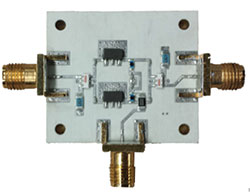
Today most MMIC power amplifiers (PA) operate with narrowband matching circuits, usually offering no more than 10 percent operational bandwidth. Market emphasis on wireless communication has driven the semiconductor industry to focus design efforts on these narrow wireless bands. Consequently, design activity on wideband performance in MMIC PAs has waned. Unfortunately, narrowband designs are not practical for wideband applications such as VHF/UHF radio, instrumentation and software-defined radios.
Where does this leave the engineer designing for wideband applications? The need for more versatile performance in MMIC PAs is still evident, and this need creates a basis for developing an application circuit to increase the bandwidth of MMIC amplifiers that usually employ narrowband matching. This article discusses an application circuit for Mini-Circuits’ GVA-91+ MMIC PA and presents test results demonstrating excellent amplifier performance significantly beyond the specified operating frequency range.
Mini-Circuits’ model GVA-91+ is a high efficiency GaAs HBT PA that operates with +5V bias and is packaged in the industry standard SOT-89. The GVA-91+ offers excellent performance over the cellular and LTE bands. With excellent matching, the PA delivers +29 dBm output power at 1 dB compression (P1dB) from 869 to 960 MHz and +27 dBm over 2110 to 2170 MHz. Power-added efficiency (PAE) at P1dB is 41 to 54 percent over these bands. This level of performance, however, is restricted to the narrow bandwidths defined by the matching circuits.
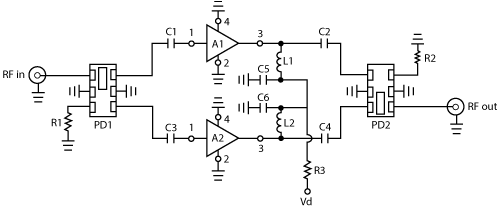
Figure 1 Balanced amplifier schematic.
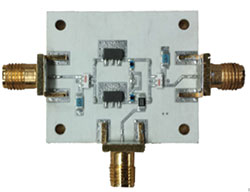
Figure 2 Balanced amplifier prototype.
To improve and extend the usability of the amplifier in a greater variety of applications, Mini-Circuits developed a board-level circuit that uses the GVA-91+ in a balanced configuration. Such a configuration using 90° hybrids offers excellent matching, limited only by the matching performance of the hybrids. Any mismatches introduced by the amplifiers, at either the input or output, will largely be dissipated in the load of the isolated port of the 90° hybrids. The balanced configuration also delivers approximately 3 dB higher output power than the individual amplifiers, while maintaining the same gain as a single amplifier.
To demonstrate this approach, a proof of concept design was created using the GVA-91+ outside of its normal frequency band. To keep the circuit small, the design used Mini-Circuits’ QCN series of LTCC 90° hybrids, which are housed in 1206 packages. The QCN series comprises 34 models with frequency bands spanning 330 MHz to 4.5 GHz and each model covering about a 2:1 bandwidth. Bandwidth is limited by the amplitude and phase unbalances intrinsic to the non-ideal 90° hybrid.
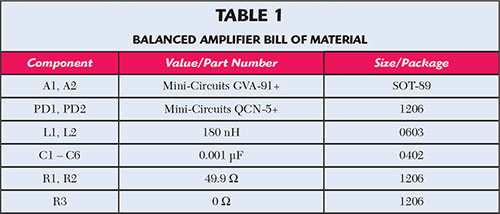
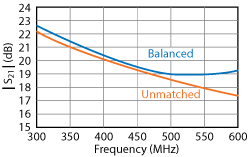
Figure 3 Small-signal gain of the single unmatched GVA-91+ compared to the balanced amplifier.
As the bandwidth of the balanced PA is limited primarily by the hybrids, using the QCN series in the application circuit enables designs to cover a range of octave frequency bands. For this article, the prototype used the QCN-5+ hybrid, which covers 330 to 580 MHz. The GVA-91+ PA and QCN-5+ hybrids were assembled in a 50Ω microstrip circuit on a printed circuit board using 0.010" thick Rogers 4350B. A schematic and photograph of the assembled application circuit are shown in Figures 1 and 2, respectively, and the bill of material is provided in Table 1.
measured RESULTS
The amplifier’s small-signal performance from 300 to 600 MHz is shown in Figures 3, 4 and 5. The measurement reference planes are at the interface of the SMA connectors and the coaxial cables that connect the application circuit to the vector network analyzer. The small-signal plots compare the balanced PA to an individual GVA-91+ without an external matching circuit. Figure 3 shows that the mismatches of the individual amplifiers degrade their gain; the small-signal gain of the balanced configuration is slightly higher than that of a stand-alone amplifier. The return loss plots in Figures 4 and 5 show the expected improvement from the balanced amplifier compared to the individual GVA-91+. The balanced configuration maintains 13 dB or better input return loss and output power over a 2:1 bandwidth.

Figure 4 Input return loss of the single unmatched GVA-91+ compared to the balanced amplifier.

Figure 5 Output return loss of the single unmatched GVA-91+ compared to the balanced amplifier.
The other advantage of the balanced configuration is increased output power. Figures 6 and 7 compare the output power at 1 and 3 dB compression to that of a single GVA-91+. From 300 to 600 MHz, the balanced amplifier delivers approximately 2 dB higher output power than a standalone GVA-91+. However, a design tradeoff is reduced power-added efficiency. Compared to the individual GVA-91+, which has 45 percent PAE at 920 MHz, the balanced configuration achieves a PAE of 27 percent at 500 MHz. Nonetheless, this compares favorably to the efficiency obtained using other wideband amplifier design topologies, such as the Darlington configuration.
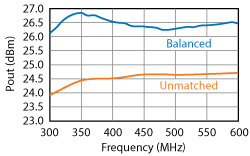
Figure 6 Output power at 1 dB compression of the single unmatched GVA-91+ compared to the balanced amplifier.
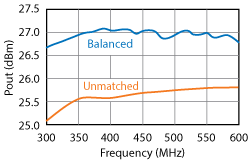
Figure 7 Output power at 3 dB compression of the single unmatched GVA-91+ compared to the balanced amplifier.
IMPROVED PERFORMANCE
This application circuit was designed to give designers flexibility when using the GVA-91+ or any SOT-89 MMIC amplifier that normally requires narrowband matching but is capable of delivering excellent performance over a much wider frequency range. The application circuit will increase the output power compared to a single amplifier specifically designed for wideband operation, such as Mini-Circuits’ PHA, PGA and GALI series and other members of the GVA family. In addition to higher output power, the design improves the matching compared to the performance of an unmatched GVA-91+ over the same frequency band.
The QCN series of LTCC 90° hybrids has a common footprint for models spanning 330 MHz to 4.5 GHz, so simply changing the 90° hybrid and amplifier, with proper modification of the bias circuit, enables designers to easily adjust the frequency coverage of the PA design.
The performance of this design can be improved further, and the bill of material reduced, with a dual matched amplifier in a single package. Mini-Circuits is developing a dual amplifier integrated circuit that combines two GVA-91+ die into a single package. This will improve amplifier matching by minimizing effects introduced by minor process variations.
Mini-Circuits
Brooklyn, N.Y.
www.minicircuits.com
